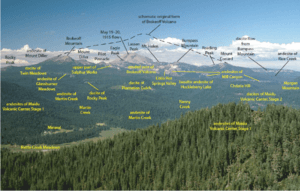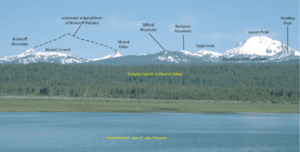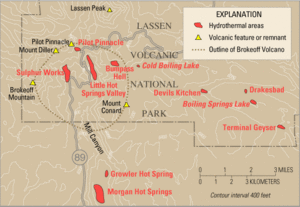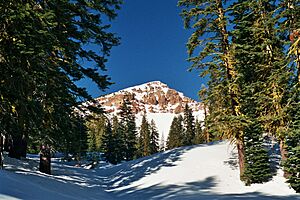Mount Tehama facts for kids
Quick facts for kids Brokeoff Volcano |
|
|---|---|
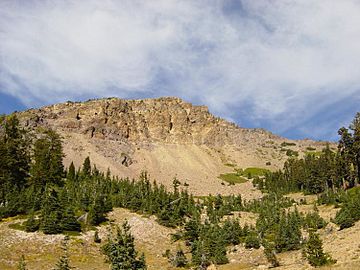
Broken northeast face of Brokeoff Volcano.
|
|
| Highest point | |
| Elevation | 9,239 ft (2,816 m) NAVD 88 |
| Prominence | 915 ft (279 m) |
| Listing | California county high points 17th |
| Geography | |
| Location | Shasta / Tehama counties, California, U.S. |
| Parent range | Cascade Range |
| Topo map | USGS Lassen Peak |
| Geology | |
| Mountain type | Eroded stratovolcano |
| Volcanic arc | Cascade Volcanic Arc |
| Climbing | |
| Easiest route | Hike |
Mount Tehama, also known as Brokeoff Volcano or Brokeoff Mountain, is an old, worn-down volcano. It is found in the Cascade Range in Northern California. Brokeoff Volcano is part of the Cascade Volcanic Arc, a chain of volcanoes.
Today, Brokeoff Mountain is the second highest peak in Lassen Volcanic National Park. It is also the highest point in Tehama County, California. Hikers who reach the top can see amazing views. They can see Lassen Peak, the Central Valley of California, and other park features. On clear days, you can even spot Mount Shasta far away.
Brokeoff Volcano was active a very long time ago. It erupted between 590,000 and 387,000 years ago. During this time, it sent out many lava flows. At its biggest, Brokeoff Volcano was huge. It was about 11,000 feet (3,350 meters) tall. Its base was about 7.5 miles (12 kilometers) around.
Around 313,000 years ago, volcanic activity started to move. It shifted to the northeast of Brokeoff Volcano. Today, the main activity is around Lassen Peak. After Brokeoff Volcano stopped erupting, hot, watery fluids moved under the ground. These fluids made the rocks near the volcano's center soft. This made them easy to break apart. Glaciers and streams then quickly wore away these soft rocks. This created deep canyons and showed the inside of the old volcano.
Many of the lava flows on the sides of Brokeoff Volcano were not softened as much. This helped keep the sides of the volcano preserved. Parts of the old volcano that are still standing include Brokeoff Mountain, Mount Conard, Pilot Pinnacle, Mount Diller, and Diamond Peak.
Contents
A Look Back: History of the Area
In the 1800s, many new settlers came to the area near Lassen Peak. Wagon trains traveled on the Nobles Emigrant Trail. This trail went right through the Lassen Peak area. One important landmark on this trail was a volcano. It was named Lassen Peak after Peter Lassen, a famous guide. People were amazed by the volcanic features, like old lava beds.
In May 1907, President Theodore Roosevelt made Lassen Peak a national monument. This was to protect the area for people to study and enjoy later. Roosevelt was told that the volcano was "extinct," meaning it would not erupt again. Local Native Americans said the mountain was still active. But settlers kept thinking Lassen Peak was "dead" and settled nearby. The natives warned that "one day the mountain would blow itself to pieces."
Almost exactly seven years later, in May 1914, the volcano began to erupt. It had many explosive eruptions over the next seven years. This brought a lot of attention to the area. In 1916, it was made a national park.
How Brokeoff Volcano Formed
California is on the Pacific Ring of Fire. This is an area with a lot of earthquakes and volcanoes. Brokeoff Volcano and other volcanoes near Lassen Peak formed because of plate tectonics. The Juan de Fuca Plate is sliding under the North American Plate. This process is called subduction.
Brokeoff Volcano is the oldest part of the Lassen volcanic area. This area has been active for over three million years. Brokeoff formed about 600,000 years ago along cracks in the Earth called faults. One of its biggest eruptions was about 50 times stronger than the 1980 eruption of Mount St. Helens.
During the Pleistocene Ice Age, new lava made of andesite flowed from the volcano's center. These lava flows piled up to build the volcano. When it reached its biggest size, it was huge. It was between 11 and 15 miles (18 and 24 kilometers) wide at its base. It stood over 11,000 feet (3,350 meters) tall. Brokeoff was active for about 200,000 years. Its eruptions included shooting out ash and rocks, and slow-moving lava flows.
Soon after Brokeoff formed, other smaller volcanoes started to grow. These included Shield volcanoes like Raker Peak and Mount Harkness. Over time, Brokeoff Volcano became worn down. Creeks and glaciers eroded it. Today, the most active volcano in the area is Lassen Peak. Other smaller craters that are less than 50,000 years old are also active.
The remains of Brokeoff are southwest of Lassen Peak in Shasta County, California. An area called Sulphur Works is thought to be the center of the old volcano. It is known for its strong, rotten-egg smell. The very middle of Brokeoff Volcano was near what is now Diamond Peak.
After Brokeoff stopped erupting, the magma (melted rock) became thicker. It also started moving towards Lassen Peak. Over the last 400,000 years, there have been at least three known lava flows. Parts of these flows are still on Raker Peak and Mount Conard. There have been at least twelve periods of volcanic activity since Brokeoff formed. This activity included pyroclastic flows (fast-moving hot gas and ash) and more lava domes. Lassen Peak is one of the vents built by this activity.
Plants and Animals
Near the start of the hiking trail, at lower elevations, you can find alder trees. There are also incense cedars, red firs, and western white pine trees. Higher up the mountain, you will see groups of mountain hemlock and colorful lupine flowers.
You might spot eagles and hawks flying high above the rocky cliffs. Smaller animals like squirrels and pika also live around the mountain.
Fun Activities and Safety
Hiking is very popular on Brokeoff Mountain during the summer. The trail usually takes between four and six hours to complete. It is about 7.4 miles (11.9 kilometers) long. From the trail, you get "exceptional" views of Mount Diller, Lassen Peak, Chaos Crags, and Mount Conard.
Even though Lassen Peak is active, the eruptions are usually small. There is some risk from the volcanoes in Lassen Volcanic National Park. Explosive eruptions have happened at Lassen Peak and Chaos Crags in the last 50,000 years. Lava flows have also occurred at other peaks. Fast-moving flows of ash and gas (pyroclastic flows) or mudflows (lahars) could happen. This is especially true near areas with glaciers or in river valleys.
Lassen Peak did erupt in the 20th century, from 1914 to 1921. Most of the activity was between 1914 and 1917. These eruptions were much smaller than the 1980 eruption of Mount St. Helens.


